Optical Study of Electronic Structure and Photoinduced Dynamics in the Organic Alloy System [(EDO-TTF)0.89(MeEDO-TTF)0.11]2PF6
Abstract
Featured Applications
Abstract
1. Introduction
2. Materials and Methods
3. Results
3.1. Anisotropy of the Electronic Structure of [(EDO-TTF)0.89(MeEDO-TTF)0.11]2PF6
3.2. M–I Phase Transition Observed in the OD Spectra of [(EDO-TTF)0.89(MeEDO-TTF)0.11]2PF6
3.3. Photoinduced Dynamics in the Low-T Insulating Phase Observed via Pump-Probe Time-Resolved Transmission Spectroscopy in the Mid-IR Range
3.4. Photoinduced Dynamics in the Low-T Insulating Phase Observed via Pump-Probe Time-Resolved Vibrational Spectroscopy in the Energy Range of the Intramolecular Vibration Modes
3.5. Discussion
Author Contributions
Funding
Acknowledgments
Conflicts of Interest
References
- Photoinduced Phase Transitions; Nasu, K., Ed.; World Scientific Publishing Co. Pte. Ltd.: Singapore, 2004; ISBN 9789812565723. [Google Scholar]
- Yonemitsu, K.; Nasu, K. Theory of Photoinduced Phase Transitions. J. Phys. Soc. Jpn. 2006, 75, 011008. [Google Scholar] [CrossRef]
- Ishiguro, T.; Yamaji, K.; Saito, G. Organic Superconductors, 2nd ed.; Springer: Berlin/Heidelberg, Germany, 1998; Volume 88, ISBN 978-3-540-63025-8. [Google Scholar]
- Chow, D.S.; Zamborszky, F.; Alavi, B.; Tantillo, D.J.; Baur, A.; Merlic, C.A.; Brown, S.E. Charge ordering in the TMTTF family of molecular conductors. Phys. Rev. Lett. 2000, 85, 1698–1701. [Google Scholar] [CrossRef]
- Clay, R.; Mazumdar, S.; Campbell, D. Pattern of charge ordering in quasi-one-dimensional organic charge-transfer solids. Phys. Rev. B 2003, 67, 115121. [Google Scholar] [CrossRef]
- Kuwabara, M.; Seo, H.; Ogata, M. Coexistence of charge order and spin–peierls lattice distortion in one-dimensional organic conductors. J. Phys. Soc. Jpn 2003, 72, 225–228. [Google Scholar] [CrossRef]
- Clay, R.T.; Ward, A.B.; Gomes, N.; Mazumdar, S. Bond patterns and charge-order amplitude in quarter-filled charge-transfer solids. Phys. Rev. B 2017, 95, 125114. [Google Scholar] [CrossRef]
- Ota, A.; Yamochi, H.; Saito, G. A novel metal-insulator phase transition observed in (EDO-TTF)2PF6. J. Mater. Chem. 2002, 12, 2600–2602. [Google Scholar] [CrossRef]
- Drozdova, O.; Yakushi, K.; Yamamoto, K.; Ota, A.; Yamochi, H.; Saito, G.; Tashiro, H.; Tanner, D. Optical characterization of 2kF bond-charge-density wave in quasi-one-dimensional 3/4-filled (EDO-TTF)2X (X = PF6 and AsF6). Phys. Rev. B 2004, 70, 075107. [Google Scholar] [CrossRef]
- Aoyagi, S.; Kato, K.; Ota, A.; Yamochi, H.; Saito, G.; Suematsu, H.; Sakata, M.; Takata, M. Direct observation of bonding and charge ordering in (EDO-TTF)2PF6. Angew. Chem. Int. Ed. 2004, 43, 3670–3673. [Google Scholar] [CrossRef] [PubMed]
- Iwano, K.; Shimoi, Y. Large electric-potential bias in an EDO-TTF tetramer as a major mechanism of charge ordering observed in its PF6 salt: A density functional theory study. Phys. Rev. B 2008, 77, 075120. [Google Scholar] [CrossRef]
- Tsuchiizu, M.; Suzumura, Y. Peierls ground state and excitations in the electron-lattice correlated system (EDO-TTF)2X. Phys. Rev. B 2008, 77, 195128. [Google Scholar] [CrossRef]
- Chollet, M.; Guerin, L.; Uchida, N.; Fukaya, S.; Shimoda, H.; Ishikawa, T.; Matsuda, K.; Hasegawa, T.; Ota, A.; Yamochi, H.; et al. Gigantic photoresponse in 1/4-filled-band organic salt (EDO-TTF)2PF6. Science 2005, 307, 86–89. [Google Scholar] [CrossRef] [PubMed]
- Onda, K.; Ogihara, S.; Yonemitsu, K.; Maeshima, N.; Ishikawa, T.; Okimoto, Y.; Shao, X.; Nakano, Y.; Yamochi, H.; Saito, G.; et al. Photoinduced change in the charge order pattern in the quarter-filled organic conductor (EDO−TTF)2PF6 with a strong electron-phonon interaction. Phys. Rev. Lett. 2008, 101, 067403. [Google Scholar] [CrossRef] [PubMed]
- Fukazawa, N.; Shimizu, M.; Ishikawa, T.; Okimoto, Y.; Koshihara, S.; Hiramatsu, T.; Nakano, Y.; Yamochi, H.; Saito, G.; Onda, K. Charge and structural dynamics in photoinduced phase transition of (EDO-TTF)2PF6 examined by picosecond time-resolved vibrational spectroscopy. J. Phys. Chem. C 2012, 116, 5892–5899. [Google Scholar] [CrossRef]
- Gao, M.; Lu, C.; Jean-Ruel, H.; Liu, L.C.; Marx, A.; Onda, K.; Koshihara, S.-Y.; Nakano, Y.; Shao, X.; Hiramatsu, T.; et al. Mapping molecular motions leading to charge delocalization with ultrabright electrons. Nature 2013, 496, 343–346. [Google Scholar] [CrossRef] [PubMed]
- Matsubara, Y.; Ogihara, S.; Itatani, J.; Maeshima, N.; Yonemitsu, K.; Ishikawa, T.; Okimoto, Y.; Koshihara, S.; Hiramatsu, T.; Nakano, Y.; et al. Coherent dynamics of photoinduced phase formation in a strongly correlated organic crystal. Phys. Rev. B 2014, 89, 161102. [Google Scholar] [CrossRef]
- Onda, K.; Yamochi, H.; Koshihara, S.Y. Diverse photoinduced dynamics in an organic charge-transfer complex having strong electron–Phonon interactions. Acc. Chem. Res. 2014, 47, 3494–3503. [Google Scholar] [CrossRef] [PubMed]
- Servol, M.; Moisan, N.; Collet, E.; Cailleau, H.; Kaszub, W.; Toupet, L.; Boschetto, D.; Ishikawa, T.; Moréac, A.; Koshihara, S.; et al. Local response to light excitation in the charge-ordered phase of (EDO−TTF)2SbF6. Phys. Rev. B 2015, 92, 024304. [Google Scholar] [CrossRef]
- Ishikawa, T.; Kitayama, M.; Chono, A.; Onda, K.; Okimoto, Y.; Koshihara, S.; Nakano, Y.; Yamochi, H.; Morikawa, T.; Shirahata, T.; et al. Probing the metal-insulator phase transition in the (DMEDO-EBDT)2PF6 single crystal by optical measurements. J. Phys. Condens. Matter 2012, 24, 195501. [Google Scholar] [CrossRef]
- Liu, L.C.; Jiang, Y.; Mueller-Werkmeister, H.M.; Lu, C.; Moriena, G.; Ishikawa, M.; Nakano, Y.; Yamochi, H.; Miller, R.J.D. Ultrafast electron diffraction study of single-crystal (EDO-TTF)2SbF6: Counterion effect and dimensionality reduction. Chem. Phys. Lett. 2017, 683, 160–165. [Google Scholar] [CrossRef]
- Murata, T.; Shao, X.; Nakano, Y.; Yamochi, H.; Uruichi, M.; Yakushi, K.; Saito, G.; Tanaka, K. Tuning of multi-instabilities in organic alloy, [(EDO-TTF)1-x(MeEDO-TTF)x]2PF6. Chem. Mater. 2010, 22, 3121–3132. [Google Scholar] [CrossRef]
- Hiramatsu, T.; Murata, T.; Shao, X.; Nakano, Y.; Yamochi, H.; Uruichi, M.; Yakushi, K.; Tanaka, K. Phase transition behavior in the mixed crystal of pristine and mono-methyl substituted EDO-TTF. Phys. Status Solidi (C) 2012, 9, 1155–1157. [Google Scholar] [CrossRef]
- Fukazawa, N.; Tanaka, T.; Ishikawa, T.; Okimoto, Y.; Koshihara, S.; Yamamoto, T.; Tamura, M.; Kato, R.; Onda, K. Time-resolved infrared vibrational spectroscopy of the photoinduced phase transition of Pd(dmit)2 salts having different orders of phase transition. J. Phys. Chem. C 2013, 117, 13187–13196. [Google Scholar] [CrossRef]
- Matsubara, Y.; Okimoto, Y.; Yoshida, T.; Ishikawa, T.; Koshihara, S.; Onda, K. Photoinduced neutral-to-ionic phase transition in tetrathiafulvalene-p-chloranil studied by time-resolved vibrational spectroscopy. J. Phys. Soc. Jpn. 2011, 80, 124711. [Google Scholar] [CrossRef]
- Ishikawa, T.; Hosoda, R.; Okimoto, Y.; Tanaka, S.; Onda, K.; Koshihara, S.; Kumai, R. Direct observations of the photoinduced change in dimerization in K-TCNQ. Phys. Rev. B 2016, 93, 195130. [Google Scholar] [CrossRef]
- Joffre, M.; Hulin, D.; Migus, A.; Antonetti, A.; Benoit à la Guillaume, C.; Peyghambarian, N.; Lindberg, M.; Koch, S.W. Coherent effects in pump-probe spectroscopy of excitons. Opt. Lett. 1988, 13, 276–278. [Google Scholar] [CrossRef]
- Hamm, P. Coherent effects in femtosecond infrared spectroscopy. Chem. Phys. 1995, 200, 415–429. [Google Scholar] [CrossRef]
- Yan, S.; Seidel, M.T.; Tan, H.-S. Perturbed free induction decay in ultrafast mid-IR pump–probe spectroscopy. Chem. Phys. Lett. 2011, 517, 36–40. [Google Scholar] [CrossRef]

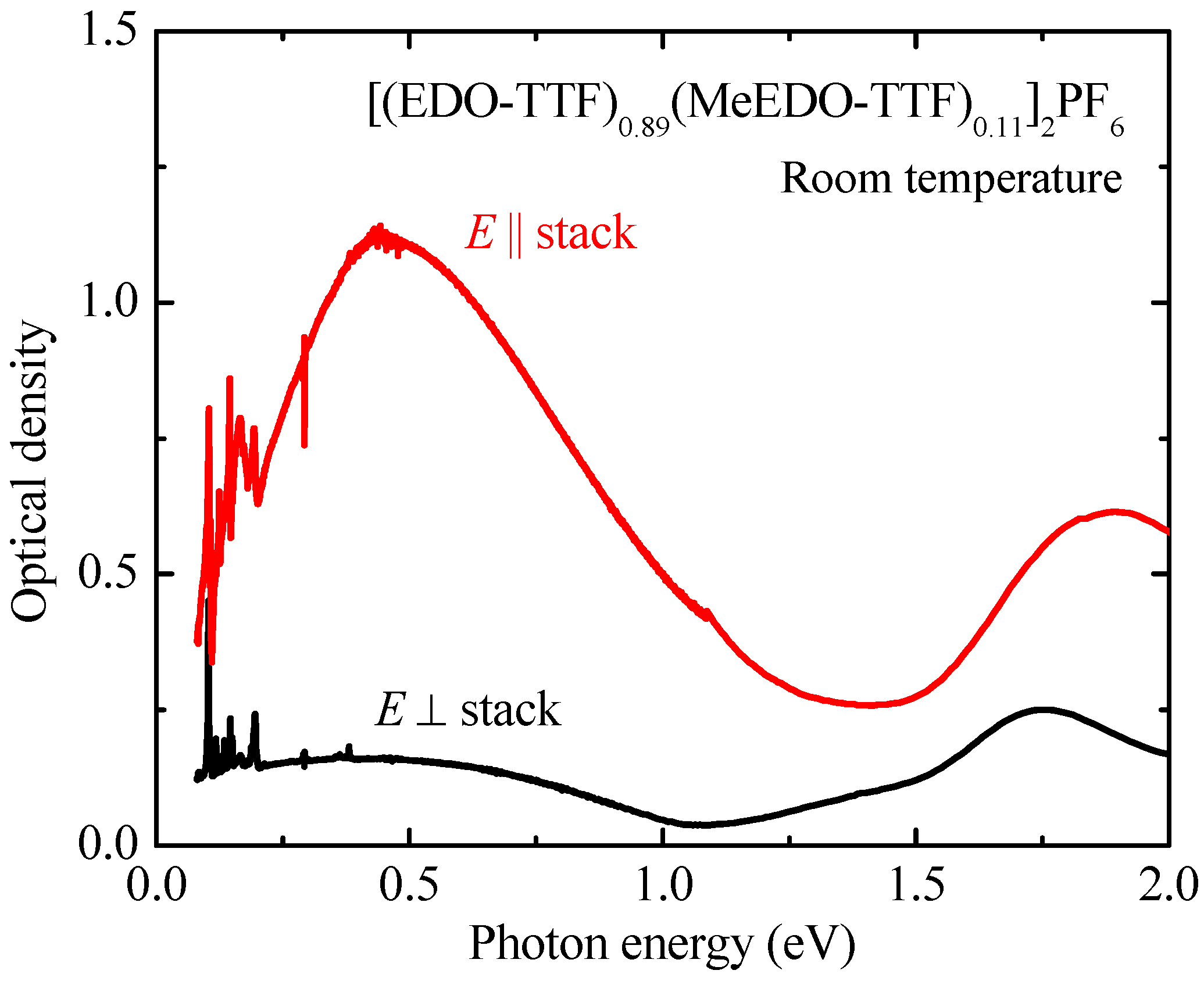
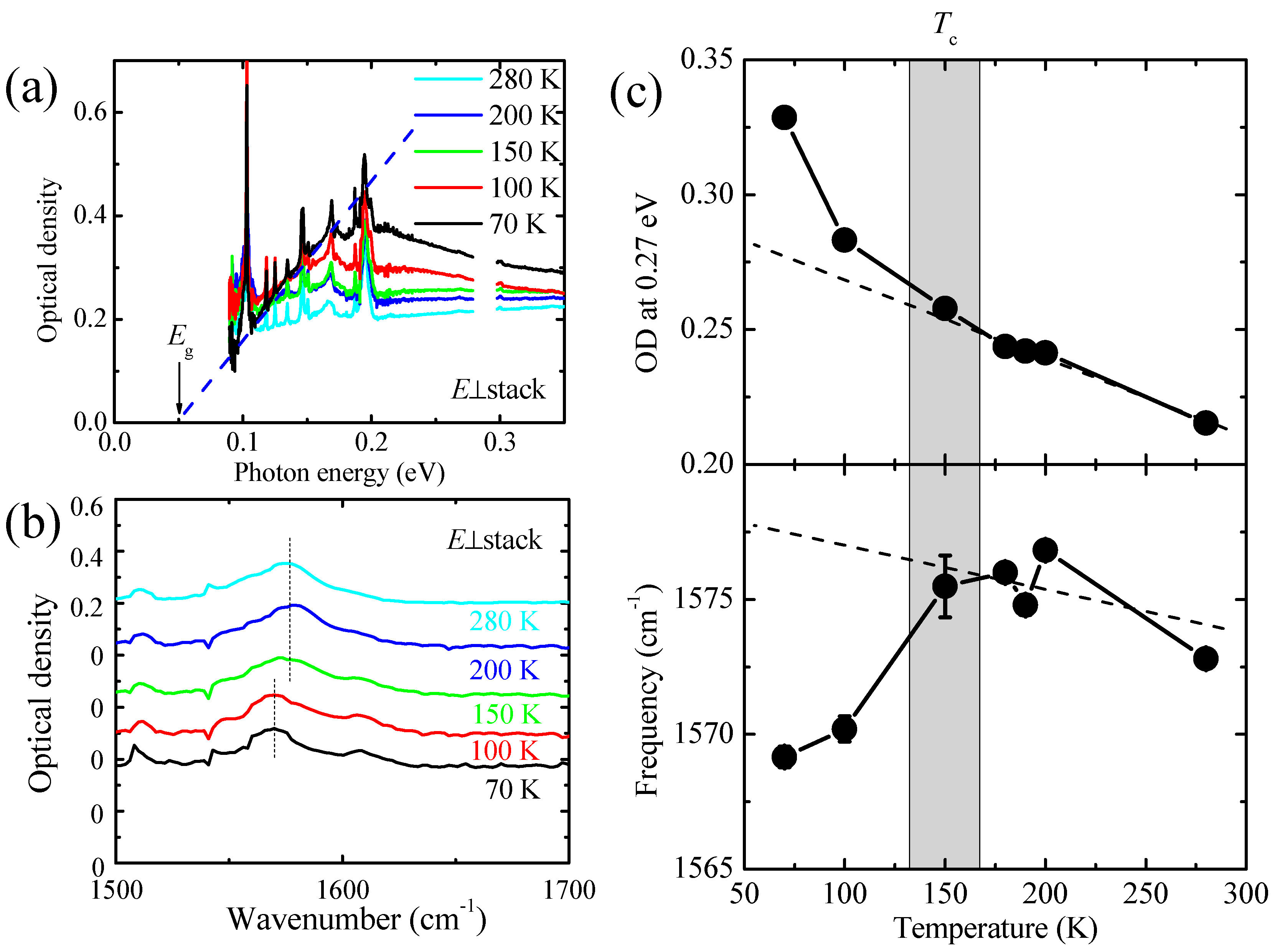
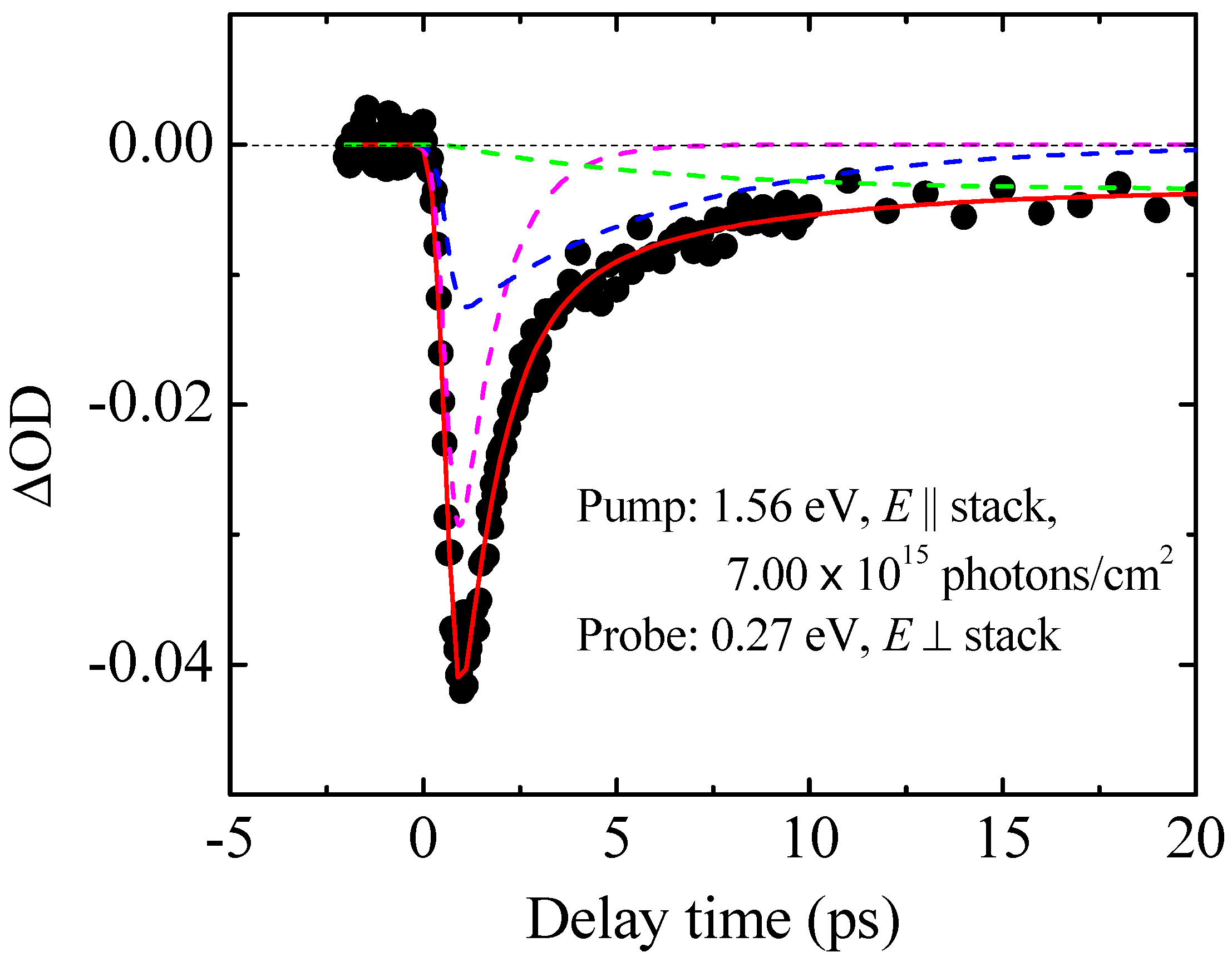
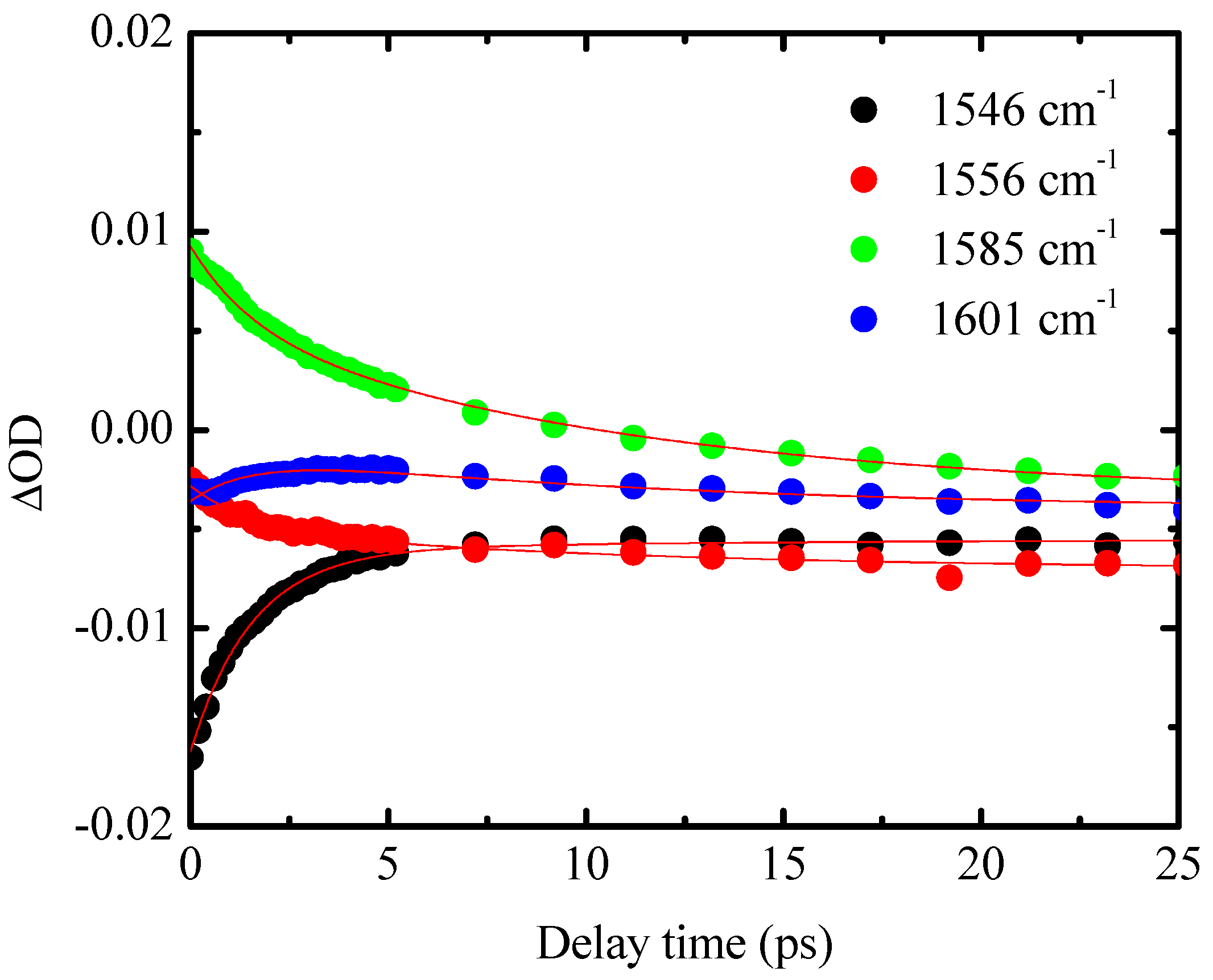
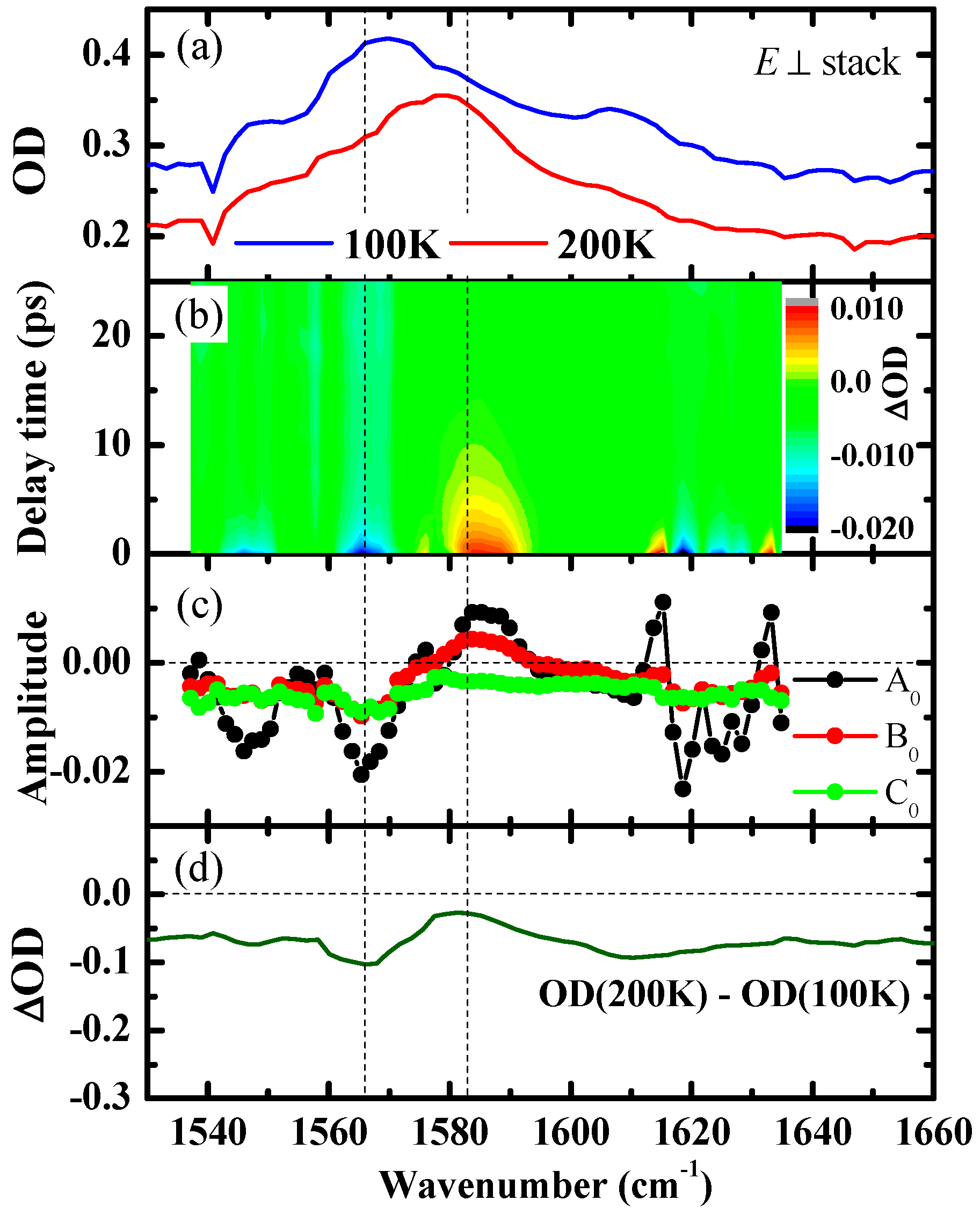
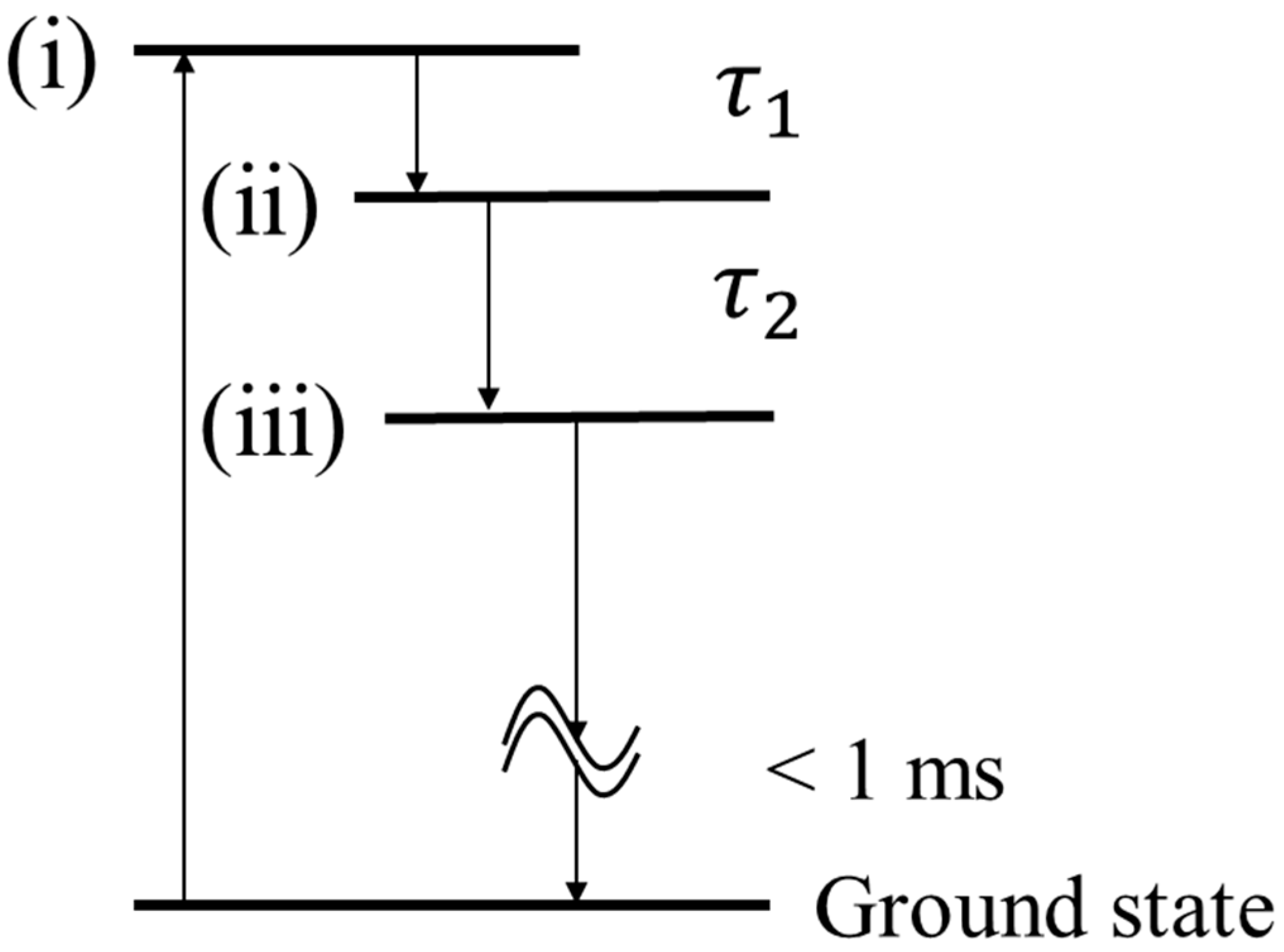
© 2019 by the authors. Licensee MDPI, Basel, Switzerland. This article is an open access article distributed under the terms and conditions of the Creative Commons Attribution (CC BY) license (http://creativecommons.org/licenses/by/4.0/).
Share and Cite
Ishikawa, T.; Urasawa, Y.; Shindo, T.; Okimoto, Y.; Koshihara, S.-y.; Tanaka, S.; Onda, K.; Hiramatsu, T.; Nakano, Y.; Tanaka, K.; et al. Optical Study of Electronic Structure and Photoinduced Dynamics in the Organic Alloy System [(EDO-TTF)0.89(MeEDO-TTF)0.11]2PF6. Appl. Sci. 2019, 9, 1174. https://doi.org/10.3390/app9061174
Ishikawa T, Urasawa Y, Shindo T, Okimoto Y, Koshihara S-y, Tanaka S, Onda K, Hiramatsu T, Nakano Y, Tanaka K, et al. Optical Study of Electronic Structure and Photoinduced Dynamics in the Organic Alloy System [(EDO-TTF)0.89(MeEDO-TTF)0.11]2PF6. Applied Sciences. 2019; 9(6):1174. https://doi.org/10.3390/app9061174
Chicago/Turabian StyleIshikawa, Tadahiko, Yohei Urasawa, Taiki Shindo, Yoichi Okimoto, Shin-ya Koshihara, Seiichi Tanaka, Ken Onda, Takaaki Hiramatsu, Yoshiaki Nakano, Koichiro Tanaka, and et al. 2019. "Optical Study of Electronic Structure and Photoinduced Dynamics in the Organic Alloy System [(EDO-TTF)0.89(MeEDO-TTF)0.11]2PF6" Applied Sciences 9, no. 6: 1174. https://doi.org/10.3390/app9061174
APA StyleIshikawa, T., Urasawa, Y., Shindo, T., Okimoto, Y., Koshihara, S.-y., Tanaka, S., Onda, K., Hiramatsu, T., Nakano, Y., Tanaka, K., & Yamochi, H. (2019). Optical Study of Electronic Structure and Photoinduced Dynamics in the Organic Alloy System [(EDO-TTF)0.89(MeEDO-TTF)0.11]2PF6. Applied Sciences, 9(6), 1174. https://doi.org/10.3390/app9061174





